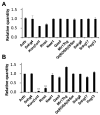Identification of Two Long Noncoding RNAs, Kcnq1ot1 and Rmst, as Biomarkers in Chronic Liver Diseases in Mice
- PMID: 39201613
- PMCID: PMC11354866
- DOI: 10.3390/ijms25168927
Identification of Two Long Noncoding RNAs, Kcnq1ot1 and Rmst, as Biomarkers in Chronic Liver Diseases in Mice
Abstract
This study investigates novel short-lived long noncoding RNAs (lncRNAs) in mice with altered expression in metabolic dysfunction-associated steatotic liver (MASH) and liver fibrosis. LncRNAs share similarities with mRNAs in their transcription by RNA polymerase II, possession of a 5' cap structure, and presence of a polyA tail. We identified two lncRNAs, Kcnq1ot1 and Rmst, significantly decreased in both conditions. These lncRNAs showed dramatic expression changes in MASH livers induced by Western diets and CCl4, and in fibrotic livers induced by CCl4 alone. The decrease was more pronounced in liver fibrosis, suggesting their potential as biomarkers for disease progression. Our findings are consistent across different fibrosis models, indicating a crucial role for these lncRNAs in MASH and liver fibrosis in mice. With MASH becoming a global health issue and its progression to fibrosis associated with hepatocarcinogenesis and poor prognosis, understanding the underlying mechanisms is critical. This research contributes to elucidating lncRNA functions in murine liver diseases and provides a foundation for developing novel therapeutic strategies targeting lncRNAs in MASH and liver fibrosis, offering new avenues for potential therapeutic interventions.
Keywords: Kcnq1ot1; Rmst; hepatocellular carcinoma; lncRNAs; mouse liver.
Conflict of interest statement
The authors declare no conflicts of interest.
Figures



References
-
- Muto H., Honda T., Tanaka T., Yokoyama S., Yamamoto K., Ito T., Imai N., Ishizu Y., Maeda K., Ishikawa T., et al. Proteomic analysis reveals changes in tight junctions in the small intestinal epithelium of mice fed a high-fat diet. Nutrients. 2023;15:1473. doi: 10.3390/nu15061473. - DOI - PMC - PubMed
-
- Ito T., Ishigami M., Zou B., Tanaka T., Takahashi H., Kurosaki M., Maeda M., Thin K.N., Tanaka K., Takahashi Y., et al. The epidemiology of NAFLD and lean NAFLD in Japan: A meta-analysis with individual and forecasting analysis, 1995–2040. Hepatol. Int. 2021;15:366–379. doi: 10.1007/s12072-021-10143-4. - DOI - PubMed
-
- Tateishi R., Uchino K., Fujiwara N., Takehara T., Okanoue T., Seike M., Yoshiji H., Yatsuhashi H., Shimizu M., Torimura T., et al. A Nationwide Survey on Non-B, Non-C Hepatocellular Carcinoma in Japan: 2011–2015 Update. J. Gastroenterol. 2019;54:367–376. doi: 10.1007/s00535-018-1532-5. - DOI - PMC - PubMed
MeSH terms
Substances
LinkOut - more resources
Full Text Sources
Medical
Miscellaneous

